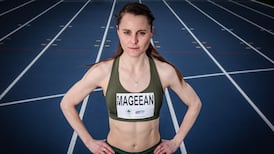“And when I was hit from behind in a crash tackle, fate decided my future sporting life for me. In the impact my shoulder was dislocated, veins and arteries were ruptured, serious blood clots formed and the nerves of my left arm were paralysed.
“I went to hospital for two months and two operations. That accident really knocked me. I came out about as weak as a baby and about as useless. I had to begin again to learn to walk, to run, to dress myself, to feed myself.”
Murray Halberg, A Clean Pair of Heels
At the top of the stairs in the house where we lived in Churchtown there was a small bookcase next to the steps into the side extension. It seemed it had always been there, the books never changed and the small mess of trophies on top made it look like clutter.
READ MORE
Across the way on the landing the banister was covered from beginning to end in running gear: jacket tops and tracksuit bottoms, t-shirts and socks and shorts, all freshly scented with mud and sweat and the odd tear of piss. At least the gear not drying down the side of the hot press.
How our mother allowed it we still don’t know. Or our sister for that matter, which is partly why they built the extension. Only this was certainly no house run by runners; just a house where the runner and his sons were always made feel comfortably at home.
Other than that it was perfectly normal. The running shoes were kept outside in the side passage and never allowed in the kitchen, where our mother ran her small home baking business, the most lucrative part of which were the bun surprises we all got every Christmas.
Unless anyone visiting went upstairs to use the only bathroom in the house, passing that banister covered in our smelly running gear, they never would have guessed so many runners lived here.
It was sometime later, aged 16 or 17, when for me running became a more serious business, that the bookcase at the top of the stairs took on a different meaning. Because there among the Agatha Christie paperbacks and unwanted travel guides were numerous hardback first editions of running books, most of which are long out of print.
Some were straight-up running biographies. Ron Clarke, The Unforgiving Minute. Herb Elliott, The Golden Mile. Peter Snell, No Bugles, No Drums. The Jim Ryun Story. The Lonely Breed.
Some were about running coaches. Arthur Lydiard, Run to The Top. Percy Cerutty, Be Fit! Or be Damned. Cerutty we still quote today: “Pain has a face, learn to recognise it. Because when it comes before you it must be your friend.”
Others were collections of stories, The Kings of Distance, about runners such as Emil Zatopek and Abebe Bikila, and on reading them even at that age it felt like they had always existed in the mind in some sort of biblical sense, like Moses and Abraham and all the rest.
In there among them too was A Clean Pair of Heels, The Murray Halberg Story. Something about the orange cover and close-up of his running spikes made it stand out perhaps, and this was an unforgettable read in many ways, which is why I’ve kept that book with me ever since. Everyone needs heroes.
Halberg was part of the New Zealand running tradition which appeared out of the proverbial nowhere in the late 1950s. Born in rural Eketahuna, in the north country, the family moved to Auckland to better themselves and it was here that fate decided his sporting life.
Then, as now, rugby was the one sport every boy played and Halberg took to it with considerable verve. Before in the winter of 1950, playing for Avondale College, the third largest secondary school in New Zealand, he was tackled from behind and his left arm was properly crippled.

Rugby’s loss became running’s gain. Undeterred, Halberg threw all his energy into that, adopting his running style until his withered left arm was no longer any great disadvantage, at least not in his own head.
It worked: he joined up with Lydiard, who first preached the joys and merits of LSD (as in long, slow distance, not lysergic acid diethylamide), and Halberg won his first senior title in 1954, two years later running New Zealand’s first sub-four minute mile.
Fate of a different sort intervened at the 1956 Olympics in Melbourne, when our own Ronnie Delany triumphed over everyone to win the 1,500 metres, Halberg left desolate back in 11th place.
“It was in me to do better,” Halberg wrote. “Yes, I was going to have another try. And this time, nothing would stop me from succeeding.”
Is this possible? Four years on, during what they still call The Golden Hour of New Zealand sport, Halberg, aged 27, did exactly that, winning the 5,000m after an unstoppable burst for home with three laps to go, that gold medal coming immediately after Peter Snell, aged 21 and also coached by Lydiard, won the 800m, despite being ranked 26th in the world beforehand.
When, four years later in Tokyo, Snell won an Olympic 800m-1,500m double – the last male athlete to do so – his place in New Zealand sporting history was complete. He was later voted New Zealand’s Sports Champion of the Century, which is saying something in a country always better known for producing All Blacks.
Snell broke six world records, twice over the mile; Halberg broke four, only he left his mark in other ways too. Retiring after the 1964 Olympics, where he finished seventh in the 10,000m, he set up the Halberg Foundation, a charitable trust which continues to enhance the lives of young people with a physical disability through sport and recreation.
Lots of people talk about the Olympic spirit of triumph over adversity; few if anyone exemplified it better than Halberg. It’s why New Zealand’s annual sporting awards are known simply as The Halbergs, and he was a rare athlete to be named a member of the Order of New Zealand, alongside the likes of Richie McCaw.
These were a rare and lonely breed indeed. John Walker later carried on this tradition, winning the 1,500m for New Zealand in Montreal in 1976. Only peeling through the pages again of A Clean Pair of Heels, on hearing Halberg had died on Wednesday evening, aged 89, came the reminder too that every age of distance runner needs heroes.
It used to be they could easily be found in places like Kenya. This week, in addressing the fact Kenya accounted for 40 per cent of doping cases over the past year, World Athletics president Sebastian Coe appeared to take some comfort when saying building back trust will be a long journey. The problem with trust among heroes is that sometimes, once broken, it can never be rebuilt.
















